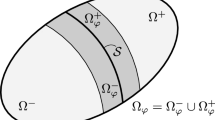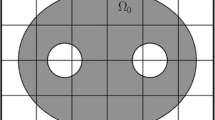Abstract
Conventional numerical implementation of the boundary element method (BEM) for elasto-plastic analysis requires a domain discretization into cells. This requires more effort for the discretization of the problem and additional computational effort. A new technique is proposed here for the analysis of 2D and 3D elasto-plastic problems with the boundary element method. In this approach the domain does not need to be discretised into cells prior to the analysis. Plasticity is assumed to start from the boundary and the cells are generated from the boundary data automatically during the analysis. Using the cell generation process, elasto-plastic analysis with the BEM becomes much more user friendly and efficient than the standard approach with a pre-definition of cells. The accuracy and efficiency of the solution obtained by the new approach is verified by several numerical examples.
Similar content being viewed by others
References
Aliabadi MH (2002) The boundary element method—applications in solids and structures. Wiley, London
Aliabadi MH, Martin D (2000) Boundary element hyper-singular formulation for elastoplastic contact problems. Int J Numer Methods Eng 48: 995–1014
Azevedo JPS, Brebbia CA (1988) An efficient technique for reducing domain integrals to the boundary. In: Boundary elements X, vol 1. Computational Mechanics Publications, pp 347–361
Banerjee PK (1994) Boundary element methods in engineering. McGraw-Hill, New Jersey
Beer G (1983) Finite element, boundary element and coupled analysis of unbounded problems in elastostatics. Int J Numer Methods Eng 19: 567–580
Beer G (2001) Programming the boundary element method. Wiley, London
Benallal A, Fudoli CA, Venturini WS (2002) An implicit bem formulation for gradient plasticity and localization phenomena. Int J Numer Methods Eng 53: 1853–1869
Bertoldi K, Brun M, Bigoni D (2005) A new boundary element technique without domain integrals for elastoplastic solids. Int J Numer Methods Eng 64: 877–906
Bonnet M, Mukherjee S (1996) Implicit bem formulation for usual and sensitivity problems in elasto-plasticity using the consistent tangent operator concept. Int J Solids Struct 33: 4461–4480
Brebbia CA, Telles JCF, Wrobel LC (1984) Boundary element technique: theory and applications in engineering. Springer, Heidelberg
Carstensen C, Zarrabi D, Stephan EP (1996) On the h-adaptive coupling of fe and be for viscoplastic and elasto-plastic interface problems. J Comput Appl Math 75: 345–363
Cecot W, Orkisz J (1992) Boundary element analysis of actual residual stresses in elastic plastic bodies under cyclic loading. Eng Anal Bound Elem 9: 289–292
Chen WF,Baladi GY (1985) Soil plasticity—theory and implementation. Elsevier, Amsterdam
Cisilino AP, Aliabadi MH, Otegui JL (1998) A three-dimensional boundary element formulation for the elastoplastic analysis of cracked bodies. Int J Numer Methods Eng 42: 237–256
Coda HB (2001) Dynamic and static non-linear analysis of reinforced media: a bem/fem coupling approach. Comput Struct 79: 2751–2765
Coda HB, Venturini WS (2000) Dynamic non-linear stress analysis by the mass matrix bem. Eng Anal Bound Elem 24: 623–632
Comi C, Maier G (1992) Extremum, convergence and stability properties of the finite-increment problem in elastic–plastic boundary element analysis. Int J Solids Struct 29: 249–270
Cruse TA, Raveendra ST, Thacker BH (1989) Bie solutions for thermoplasticity by collocation. In: Kuhn G, Mang H(eds) Discretization mehtods in structural mechanics. Springer, Heidelberg, pp 29–38
Davis BA, Gramann PJ, Matzig JC, Osswald TA (1994) Dual-reciprocity method for heat transfer in polymer processing. Eng Anal Bound Elem 13: 249–261
Elleithy WM, Tanaka M, Guzik A (2004) Interface relaxation fem–bem coupling method for elasto–plastic analysis. Eng Anal Bound Elem 28: 849–857
Frangi A, Maier G (1999) Dynamic elastic–plastic analysis by a symmetric galerkin boundary element method with time-dependent kernels. Comput Methods in Appl Mech Eng 171: 281–308
Gao X (2002) A boundary element method without internal cells for two-dimensional and three-dimensional elastoplastic problems. Trans ASME 69: 154–160
Gao XW, Davies TG (2002) Boundary element programming in mechanics. Cambridge University Press, Cambridge
Gun H, Becker A (1998) Boundary element formulation in elastoplastic stress analysis. Math Comput Appl 3: 139–151
Gupta A, Delgado HE, Kane JH, Prasad KG (1992) Elasto-plastic boundary element analysis utilizing a zone condensation technique. Comput Struct 43: 595–604
Hatzigeorgiou GD, Beskos DE (2002) Dynamic elastoplastic analysis of 3-d structures by the domain/boundary element method. Comput Struct 80: 339–347
Hatzigeorgiou GD, Beskos DE (2002) Dynamic response of 3-d damaged solids and structures by bem. Computer Modeling in Engineering and Science 3: 791–802
Hatzigeorgiou GD, Beskos DE (2002) Static analysis of 3d damaged solids and structures by bem. Eng Anal Bound Elem 26: 521–526
Herding U, Kuhn G (1996) A field boundary element formulation for damage mechanics. Eng Anal Bound Elem 18: 137–147
Huesmann A, Kuhn G (1995) Automatic load incrementation technique for plane elastoplastic frictional contact problems using boundary element method. Comput Struct 56: 733–744
Ikeda T, Yamashita A, Miyazaki N (1998) Elastic–plastic analysis of crack in adhesive joint by combination of boundary element and finite element methods. Comput Mech 21: 533–539
Ingber MS, Mammoli AA, Brown MJ (2001) A comparison of domain integral evaluation techniques for boundary element methods. Int J Numer Methods Eng 52: 417–432
Israil ASM, Banerjee PK (1992) Advanced development of boundary element method for two-dimensional dynamic elasto-plasticity. Int J Solids Struct 29: 1433–1451
Kabele P, Yamaguchi E, Horii H (1999) Fem–bem superposition method for fracture analysis of quasi-brittle structures. Int J Fract 100: 249–274
Karam VJ, Telles JCF (1992) Bem applied to plate bending elastoplastic analysis using reissner’s theory. Eng Anal Bound Elem 9: 351–357
Karami G (1991) Boundary element analysis of elasto-plastic contact problems. Comput Struct 41: 927–935
Leitao V, Aliabadi MH, Rooke DP (1995) Elastoplastic dual boundary element: applications to crack-face contact. Comput Struct 54: 443–454
Leitao V, Aliabadi MH, Rooke DP (1995) Elastoplastic simulation of fatigue crack growth—dual boundary element formulation. Int J Fatigue 17: 353–363
Lin F, Yan G, Bazant Z, Ding F (2002) Nonlocal strain-softening model of quasi-brittle materials using boundary element method. Eng Anal Bound Elem 26: 417–424
Liu Q, Cen Z, Xu B (1997) Plastic analysis by quasi-high order galerkin bem. Eng Struct 19: 1050–1056
Lorenzana A, Garrido JA (1999) Analysis of the elastic–plastic problem involving finite plastic strain using the boundary element method. Comput Struct 73: 147–159
Ma H, Kamiya N, Xu S (1998) Complete polynomial expansion of domain variables at boundary for two-dimensional elasto-plastic problems. Eng Anal Bound Elem 21: 271–275
Maier G, Novati G, Cen Z (1993) Symmetric galerkin boundary element method for quasi-brittle-fracture and frictional contact problems. Comput Mech 13: 74–89
Maier G, Miccoli S, Novati G, Perego U (1995) Symmetric galerkin boundary element method in plasticity and gradient plasticity. Comput Mech 17: 115–129
Mallardo V, Alessandri C (2004) Arc-length procedures with bem in physically nonlinear problems. Eng Anal Bound Elem 28: 547–559
Martín D, Aliabadi MH (1998) Boundary element analysis of two-dimensional elastoplastic contact problems. Eng Anal Bound Elem 21: 349–360
Nicholson D, Kassab A (2000) Explicit boundary element method for nonlinear solid mechanics using domain integral reduction. Eng Anal Bound Elem 24: 707–713
Noronha M, Müller A, Pereira A (2005) Analysis of elastoplastic problems with a pure-bem. In: XXVI Iberian Latin–American congress on computational methods in engineering—CILAMCE, Universidade Federal do Espfrito Santo, Guarapari
Nowak AJ, Neves AC (1994) The multiple reciprocity boundary element method. Computational Mechanics Publications
Okada H, Rajiyah H, Atluri SN (1990) Full tangent stiffness field-boundary-element formulation for geometric and material non-linear problems of solid mechanics. Int J Numer Methods Eng 29: 15–35
Partridge PW, Brebbia CA, Wrobel LC (1992) The dual reciprocity boundary element method. Computational Mechanics Publications
Pavlatos GD, Beskos DE (1994) Dynamic elastoplastic analysis by bem/fem. Eng Anal Bound Elem 14: 51–63
Polizzotto C, Zito M (1998) Biem-based variational principles for elastoplasticity with unilateral contact boundary conditions. Eng Anal Bound Elem 21: 329–338
Providakis C (1997) Transient boundary element analysis of elastoplastic plates on elastic foundation. Soil Dyn Earthq Eng 16: 21–27
Providakis C, Toungelidis G (1998) A d/bem approach to the transient response analysis of elastoplastic plates with internal supports. Eng Comput 15: 501–517
Providakis CP (1996) A general and advanced boundary element transient analysis of elastoplastic plates. Eng Anal Bound Elem 17: 133–143
Rajgeli S, Amadio S, Nappi A (1992) Application of damage mechanics concepts to the boundary element method. In: Boundary element technology VII. Elsevier, Amsterdam, pp 617–634
Shangwu X, Rodrigues J, Martins P (1999) Simulation of plane strain rolling through a combined finite element-boundary element approach. J Mater Process Technol 96: 173–181
Sládek J, Sládek V (1995) Boundary element analysis for an interface crack between dissimilar elastoplastic materials. Comput Mech 16: 396–405
Sládek J, Sládek V (1995) Boundary element method for thermoelastoplastic problems. Int J Numer Methods Eng 38: 3635–3652
Sládek J, Sládek V, Baẑant ZP (2003) Non-local boundary integral formulation for softening damage. Int J Numer Methods Eng 57: 103–116
Stein E, Kreienmeyer M (1998) Coupling of bem and fem by a multiplicative schwarz method and its parallel implementation. Eng Comput 15: 173–189
Aliabadi M, Aliabadi M (2006) Boundary element method for shear deformable plates with combined geometric and material nonlinearities. Engineering Analysis with Boundary Elements 30: 31–42
Wen PH, Aliabadi MH, Rooke DP (1998) A new method for transformation of domain integrals to boundary integrals in boundary element method. Commun Numer Methods Eng 14: 1055–1065
Zhang Q, Mukherjee S, Chandra A (1992) Design sensitivity coefficients for elasto-viscoplastic problems by boundary element methods. Int J Numer Methods Eng 34: 947–966
Zhang X, Liu Y, Zhao Y, Cen Z (2002) Lower bound limit analysis by the symmetric galerkin boundary element method and the complex method. Comput Methods Appl Mech Eng 191: 1967–1982
Author information
Authors and Affiliations
Corresponding author
Rights and permissions
About this article
Cite this article
Ribeiro, T.S.A., Beer, G. & Duenser, C. Efficient elastoplastic analysis with the boundary element method. Comput Mech 41, 715–732 (2008). https://doi.org/10.1007/s00466-007-0227-1
Received:
Accepted:
Published:
Issue Date:
DOI: https://doi.org/10.1007/s00466-007-0227-1




